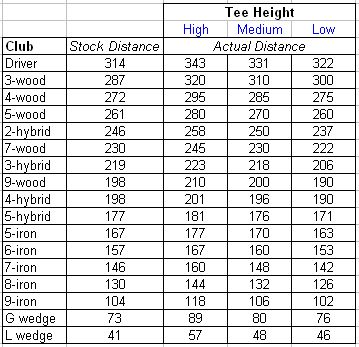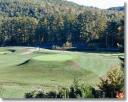Comparing Distance with Tees and Spin
By Deprecated: Function the_author_posts_link was called with an argument that is deprecated since version 2.1.0 with no alternative available. in /var/web/site/public_html/wp-includes/functions.php on line 6121 Golden Tee Fan • Category: Backspin, roll and bite, Driving, Home Edition • • Leave a Comment (0)With the luxury of a Golden Tee Home Edition, I was finally able to compare club-for-club how tee height and spin affect your distance off the tee. This article will show you how much distance you can expect to gain or lose with each of these options.
First, let me explain how I set up these experiments. I needed a hole with a long, mostly flat fairway from this year or last so that I could use tees. After poking around, Falcon Sands #9 seemed like a good candidate. It’s a par 5 with a big fairway straight ahead to start off. I made sure the weather was perfect, so remember that as weather worsens, so does your distance once the ball hits the ground. This fairway was not totally flat — no fairways are. So, little mounds here and there may have affected distance. Finally, there was a small 3MPH wind that may have affected distance a couple yards.
All these shots were “firm” B2 shots — straight back to B, and forward to 2 hit fairly firm. I figured this represented the skill of an amateur player who plays several rounds per month. Beginners will likely see less distance, while those who can execute a smooth hammer shot will see greater distance. I attempted each shot until I was comfortable that it was struck with the same consistency as the others, but human error will likely see a variation of a couple yards here and there. I used both the Flares and the Hawks with the Hurtles for this setup.
SO, let’s take a look at some data when comparing shots with high, medium, and low tees. In these charts, the “Stock Distance” is the term I gave to the game’s estimated distance you see in the overview pane in the lower left of your screen:

HIGH TEES:
- Not as effective with long woods (10-12 extra yards)
- Least effective with hybrids (5 extra yards)
- More effective with 7-9 woods (12-15 extra yards)
- Expect 7 extra yards with medium irons
- Most effective with high-lofted irons (12 extra yards)
LOW TEES:
- Fairly consistent decrease in distance of 3-5% across all clubs
- Expect 10 less yards with long woods
- Expect 12 less yards with long hybrids
- Expect 5-6 less yards with medium hybrids
- Expect 6-7 less yards with irons
Now let’s take a look at how spin affects your distance:

ROLL:
- Has a huge effect on high-lofted clubs — expect 13-14 extra yards with your 9-iron and wedges
- High irons see 12 extra yards
- Medium irons see 10 extra yards
- Hybrids gain 13-16 yards
- 7-wood gains 18 yards, but 9-wood only gains 13
- 4 and 5 wood gain 13-14 yards
- Driver and 3-wood gain 10-12 yards
- In general, more loft = more roll! Perhaps this is due to more bounce when the ball hits grass due to the loft and angle of descent, as opposed to the friction of low-lofted shots running along the grass and slowing down.
BACKSPIN:
- Expect about 12 less yards with a driver
- Expect 15-18 less yards with 3-5 woods
- Expect 10 less yards with 7-9 woods
- Expect only 4-5 less yards with hybrids, where backspin is least effective relative to distance
- Expect 11-12 less yards with the 5-6 irons
- Expect 7-8 less yards with high-lofted irons and wedges
- Overall, distance decreases 4-5% with woods and 5-7% with irons. As with curve shots, irons generate more spin for roll and backspin.
BITE:
- Fairly consistent 2-4% decrease in distance vs. no spin
- For hybrids, expect almost no change in distance
Now you know what to expect among the different tee heights and different types of spin, but what about roll vs. a high tee or a low tee vs. backspin? Let’s take a look at a grid where the different tee heights (High, Medium, Low), the different types of spin (Roll, Bite, Back), and the “Stock” distance are all compared. In this chart, you’ll observe decreasing distance as you move from left to right (Total Yards for all clubs in these tests is shown at the bottom of each column):

ROLL vs. HIGH TEE:
- Same for driver and 3-wood. For long drives off the tee, you’ll only see more distance with a high tee vs. roll if you have a big tailwind.
- The other woods will give you 3-4 more yards with roll vs. high tee.
- You’ll get 5 more yards out of the 2-hybrid with roll, but you’ll get 10 more yards out of the other hybrids.
- 5-9 irons show about the same distance.
- Wedges will get you a few more yards with roll.
BACKSPIN vs. LOW TEE:
- Backspin gets you a few less yards than a low tee for the woods; a 9-wood is about the same.
- Backspin is a couple yards longer for hybrids.
- Backspin is 4-5 yards less for medium irons and wedges.
- Backspin is a couple yards less for high-lofted irons.
IN SUMMARY:
- Most players hit farther than the given “stock” distance. A firm B2 shot with bite is the closest thing to that distance.
- High tees are most effective with high-lofted clubs, while low tees see a fairly consistent decrease in distance across all clubs.
- Roll is also most effective with high-lofted clubs, while the effect of backspin is noticed the most with irons.
- For most clubs, roll gets you more distance than a high tee. A high tee may still be longer with a big tailwind.
For the full set of data, click here to view the spreadsheet! Hopefully these experiments helped you learn a thing or two to help manage your distance off the tee, and also with approach shots into greens since the effects of spin will be similar.




